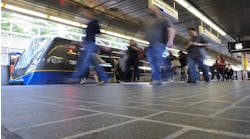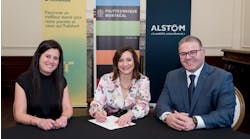On Jan. 6, a new era of safety, comfort and convenience arrived at Metro as the first 7000-series train pulled into Greenbelt Station. The newest addition to the rail fleet will fulfill a critical National Transportation Safety Board (NTSB) recommendation by replacing Metro’s oldest cars, while also adding train capacity.
Metro General Manager and CEO Richard Sarles was joined by Sen. Barbara Mikulski, Sen. Ben Cardin, Gov. Martin O’Malley, Mayor Vincent Gray and other officials for a tour of the new cars, which include many new design features that were suggested by customers.
The cars will be tested on the system over the next several months, and Metro will send data back to the Kawasaki production facility in Lincoln, Neb. to finalize the railcar design process. Full-scale production of the new cars is expected to begin in mid-2014.
“For all that Metro does to keep government running, get people to work and get cars off the road, this investment in Metro is about safety. These new 7000 series cars are the next generation of safer cars to ride the rails of Washington’s Metro,” said Mikulski, who fought to get the first-ever federal rail transit safety standards passed into law. “I have fought every year to deliver dedicated funding for Metro’s capital improvements, keeping safety on track on America’s Subway. I will not rest until Metro is safe for those who work on it and those who ride on it.”
The modern rail cars are equipped with state-of-the-art safety technology and numerous features designed with extensive customer input. Through the project’s customer design team, actual Metro riders participated in the design of the new railcars at every phase of the process. In addition, seat design options were tested with Metrorail riders in several stations, and Metro’s Accessibility Advisory Committee (AAC) and Riders’ Advisory Council (RAC) provided input.
Elements of the car that were influenced by customer feedback include:
- Interior layout, including placement of hand holds, privacy screens and seat positions
- Seat design and material
- Flooring materials and colors
- Lighting
- Design of exterior front of the train
- Accessibility elements, including markings of priority seating and call buttons
Safety is at the forefront in the design of the 7000-series cars, which are:
- Built to meet improved crashworthiness standards to absorb maximum energy in the event of a collision,
- Equipped with event recorders, meeting federal requirements,
- Constructed to meet rigorous fire safety standards, including those from the National Fire Protection Association and the American Public Transportation Association,
- Equipped with digital video surveillance systems, providing full coverage of the passenger area, operator cab and front windshield, and
- Equipped with “anti-climbers” that help keep cars upright and in-line in the event of a collision.
In addition, each individual railcar, as well as the overall vehicle design, manufacturing and testing, is undergoing a rigorous Safety and Security Certification process as required by the Federal Transit Administration (FTA).
“This is all about safety. Metro has a recognized responsibility to keep its riders and its employees as safe as possible. The arrival of new 7000-series cars, made possible by dedicated funding from the federal government and local jurisdictions, translates into greater safety and expanded service for our communities, especially the federal government which relies on Metro daily and in times of crisis,” said Cardin, who, as a member of the Senate Environment and Public Works Committee, pushed forward the authorization needed to provide Metro with consistent, annual funding that would give Metro the ability to make such major capital investments.
"The new 7000-Series Metro cars will provide the state of Maryland and the Washington, DC region with better safety and reliability features, two elements critical to a successful transit network," O'Malley said. "By making modern investments in our transit system we not only strengthen our regional economy today, we expand opportunity for generations to come."
“I am pleased that the District of Columbia is playing a major role in helping to build a safer, more reliable Metro system by providing funding that supports the acquisition of the 7000-series trains along with other needed projects,” Gray said. “I applaud Metro for making these advancements at a time when the District’s population is steadily growing.”
“The 7000-series of rail cars represents a giant leap forward for Metro,” stated Congressman Steny Hoyer. “Not only will this next generation of rail cars meet the growing transportation needs of our region, but they will increase the safety of Metro for millions of residents, commuters, and visitors. I’m also pleased that these state-of-the-art rail cars were built right here in America. Supporting the safety, development, and growth of the Metro system has been a top priority throughout my career, and I will continue to partner with the Washington Metro area delegation to ensure robust funding for the WMATA system. I thank Richard Sarles and the WMATA Board for their dedication to safe and reliable service, and I look forward to seeing the 7000-series cars put into operation soon.”
"The series-7000 railcars represent a federal commitment to provide the funding necessary to ensure safety and reliability for Metro’s riders in the region and from across the country,” said Edwards. “These cars will help Metro meet an increase in ridership in Maryland and throughout the metropolitan region, and will do so in a way that is safe and responsible.”
“We have been eagerly waiting for these state-of-the-art cars since the 2009 Metro accident that reemphasized the need for reconstruction of Metro,” said Congresswoman Eleanor Holmes Norton (D-DC). “The actual appearance of these rider-responsive, safety-first cars will make our struggle for the funding worth it, and, I believe, will encourage riders to be more accepting of the inconveniences that come with bringing our nearly 40-year-old system into the 21st century.”
The 7000-series cars feature new technologies that are generations ahead of Metro’s current railcars, all of which were designed to be “backward compatible” with Metro’s oldest cars, the 1000-series. For example, Metro’s current railcars use analog technology for onboard public address announcements, whereas the P.A. systems on 7000-series cars will be entirely digital and feature clear, automated announcements.
“By starting with a blank slate, we are able to bring to Metro riders the latest in safety, comfort, convenience and technology,” Sarles said. “We are grateful for the funding support from the federal government and the jurisdictions that has made this day possible. These cars are also distinct in that they have been designed with extensive input from our riders, who gave our team feedback on everything from seat colors and lumbar support, to hand holds and electronic displays. ”
The new rail cars include a customer-preferred blue and grey interior color scheme and offer a slate of new features and customer amenities, including:
- Stainless steel car body for increased durability
- 64 vinyl padded seats and seat-back hand grasps
- Six different station destination signs, including two dynamic LCD route maps and four video screens in each car
- LCD map displays to allow customers to easily track their location
- LED screens that provide current and upcoming station information
- Improved seats that provide more knee room and better lumbar support
- Wider aisles (34 inches verses 32 inches on older cars) to facilitate movement within the car
- Additional space near the doors for standees and wheelchairs
- Resilient nonslip flooring, rather than carpet
- High-tech automated public address systems
- Closed circuit cameras for added safety and security
- More reliable door systems using proven technology
- Added handholds in the door area and vertical poles added at each seat – for a total of 25 percent more linear feet of bars than in Metro’s 6000-series cars
- Enhanced lighting and privacy screens in the vestibule area
The first 7000-series trains, which will all be eight-cars in length, are expected to enter service late this year. Unlike earlier railcar series that can be “mixed and matched” within a single train, the 7000-series cars will operate only with other 7000-series cars. The cars will also be in a “quad-unit configuration,” meaning that the cars will operate in four-car sets, allowing the accommodation of 40 more passengers per eight-car train than an older models because of fewer operator compartments.
By 2018, more than half of Metrorail’s fleet is expected to be comprised of 7000-series cars. Metro currently has 528 new railcars on order — 300 to replace all 1000-series cars, fulfilling a recommendation of the National Transportation Safety Board, plus an additional 128 cars to handle ridership growth as a result of the Silver Line. The 7000-series cars will run throughout the Metrorail system, on all lines. Sarles has announced that, as part of Metro’s 2025 strategic plan, the Authority hopes to order another 220 cars in 2015 to provide more eight-car trains (the longest possible length) for more capacity during peak periods.
“Metro’s Board has adopted a strategic plan that first maximizes the capacity that we have on the system by operating more eight-car trains to serve today’s riders and prepare for growing demand,” said Metro Board Chair Tom Downs. “We look forward to operating these new cars on every Metro line, including the Silver Line, which will begin service this year.


